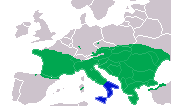Italian Aesculapian snake
| Italian Aesculapian snake | ||||||||||||
|---|---|---|---|---|---|---|---|---|---|---|---|---|

Italian Aesculapian Snake ( Zamenis lineatus ) |
||||||||||||
| Systematics | ||||||||||||
|
||||||||||||
| Scientific name | ||||||||||||
| Zamenis lineatus | ||||||||||||
| ( Camerano , 1891) |
The Italian Aesculapian snake ( Zamenis lineatus ), also known as the South Italian Aesculapian snake , is a non-poisonous species of snake belonging to the family of the adder (Colubridae). A very similar species is the Aesculapian snake ( Zamenis longissimus ).
etymology
The German name "(South) Italian Aesculapian Snake" indicates the distribution in (South) Italy. The specific epithet "lineatus" is derived from the Latin "linea" for "stroke" or "line" and refers to the longitudinally striped drawing of the animal.
description
The Italian Aesculapian snake is a large, strong snake with a slim body, but does not reach the maximum dimensions of the Aesculapian snake. When fully grown, Zamenis lineatus usually measures 130 to 150, rarely up to 170 cm. The upper side of the body is colored light brown, yellowish olive or olive brown. The ventral side is noticeably spotted, especially in the rear area. A conspicuous drawing made up of mostly four dark vertical stripes can often be seen. The strips are narrower than the distances between them. The pupils are round and surrounded by an orange to red colored iris.
Zamenis lineatus differs from Zamenis longissimus, among other things, in its generally lighter appearance, the red iris and the longitudinal stripes ( if Z. longissimus is longitudinally striated, it usually has 2 stripes, which are wider than the distance between them).
Systematics
Camerano first described the species in 1891 as a subspecies under the name Callopeltis longissimus var. Lineata . Afterwards, too, it was long considered a subspecies of the Aesculapian snake and was called Elaphe longissima romana . In 1999, Lenk & Wüster granted the Italian Aesculapian snake its own species status. Since then it has been known as Elaphe lineata , before being replaced by Utiger et al. was transferred to the genus Zamenis . No subspecies of Zamenis lineatus are known, the species is therefore monotypical .
distribution

The distribution area extends within Italy from the central Italian region of Latium to the south of Italy and across the island of Sicily . Areas at altitudes between 0 and 1955 m, but mostly between 300 and 900 m above sea level, are populated, in central Italy mainly in plains. The inhabited biotopes, such as clearings, marginal areas of light forests, ruins, stone walls and also gardens, are characterized by a generally dry climate and Mediterranean hard-leaved vegetation , sometimes bodies of water are not far away. Boulders and bushes often serve as hiding places. Insufficient information is available to assess the endangerment level of the species.
Way of life
The behavior of Zamenis lineatus is still relatively little investigated. It leads a shy way of life and seems to be more attached to the ground than Zamenis longissimus . The mating season extends over the months of April and May. When mating, the male fixes the female with a bite in the neck . The species reproduces through oviparity , so it is egg-laying. The prey spectrum of Zamenis lineatus includes smaller mammals and birds and, to a lesser extent, lizards .
Individual evidence
- ↑ Zamenis lineatus in The Reptile Database ; accessed on April 5, 2012.
- ↑ a b IUCN Red List: Zamenis lineatus
literature
- Dieter Glandt: Pocket Lexicon of Reptiles and Amphibians in Europe , Quelle & Meyer, Wiebelsheim 2010, ISBN 978-3-494-01470-8 .